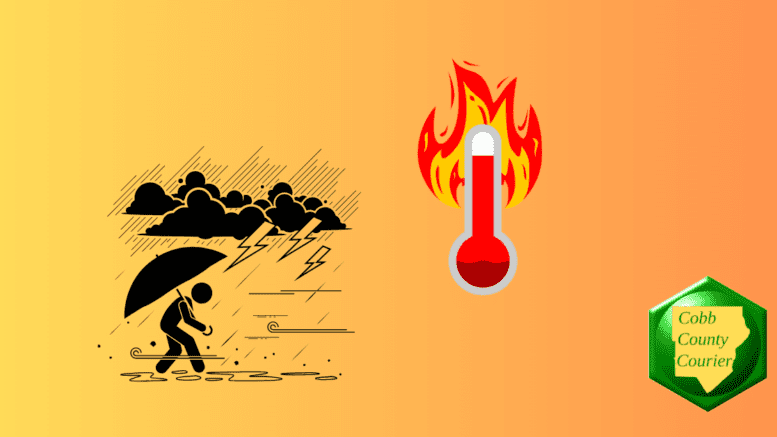The National Weather Service has issued a hazardous weather outlook for north and central Georgia, warning of isolated thunderstorms today with dangerous heat index levels potentially reaching 104 degrees.
The National Weather Service issued a hazardous weather outlook for Cobb County and other parts of north and central Georgia for Thursday, July 17.
Bonus for the more weather-curious among you … To read an article about interpreting a weather news report with some of the typical terminology defined, follow this link.
What is in the statement?
The statement gives the following details:
This Hazardous Weather Outlook is for north and central Georgia.
.DAY ONE…Today and Tonight…
Isolated thunderstorms possible this afternoon. A couple storms may have gusty winds, heavy rainfall, and frequent lightning.
Heat index values will range between 100 and 104 today in portions of north and central Georgia.
.DAYS TWO THROUGH SEVEN…Friday through Wednesday…
Scattered to widespread thunderstorms are expected Friday through Monday. The threat for organized severe weather remains low, but very heavy rainfall and localized flooding will be possible.
Heat index values will range from 100 to 105 degrees, possibly higher, across portions of north and central Georgia each day.
What counties are affected?
The following counties are included in the hazardous weather outlook:
Baldwin, Banks, Barrow, Bartow, Bibb, Bleckley, Butts, Carroll, Catoosa, Chattahoochee, Chattooga, Cherokee, Clarke, Clayton, Cobb, Coweta, Crawford, Crisp, Dade, Dawson, DeKalb, Dodge, Dooly, Douglas, Emanuel, Fannin, Fayette, Floyd, Forsyth, Gilmer, Glascock, Gordon, Greene, Gwinnett, Hall, Hancock, Haralson, Harris, Heard, Henry, Houston, Jackson, Jasper, Jefferson, Johnson, Jones, Lamar, Laurens, Lumpkin, Macon, Madison, Marion, Meriwether, Monroe, Montgomery, Morgan, Murray, Muscogee, Newton, North Fulton, Oconee, Oglethorpe, Paulding, Peach, Pickens, Pike, Polk, Pulaski, Putnam, Rockdale, Schley, South Fulton, Spalding, Stewart, Sumter, Talbot, Taliaferro, Taylor, Telfair, Toombs, Towns, Treutlen, Troup, Twiggs, Union, Upson, Walker, Walton, Warren, Washington, Webster, Wheeler, White, Whitfield, Wilcox, Wilkes, Wilkinson
What is meant by “isolated” and “scattered”?
The NWS defines “isolated” as follows:
A National Weather Service convective precipitation descriptor for a 10 percent chance of measurable precipitation (0.01 inch). Isolated is used interchangeably with few.
“Scattered” has the following definition:
When used to describe precipitation (for example: “scattered showers”) – Area coverage of convective weather affecting 30 percent to 50 percent of a forecast zone (s).
Isolated Thunderstorms:
Isolated thunderstorms are relatively rare occurrences that happen sporadically and are generally confined to a limited area.
These thunderstorms are often characterized by being few and far between, with significant gaps between individual storm cells.
Typically, isolated thunderstorms cover less than 20% of the forecast area.
Despite their isolated nature, these storms can still be intense and may produce heavy rain, lightning, gusty winds, and possibly hail.
Scattered Thunderstorms:
Scattered thunderstorms are more widespread than isolated thunderstorms and cover a larger portion of the forecast area.
In a scattered thunderstorm scenario, numerous individual thunderstorms develop, but they are not continuous or widespread enough to be classified as a “line” or “cluster” of storms.
Scattered thunderstorms generally cover between 30% to 50% of the forecast area.
Although scattered thunderstorms are more widespread, they still leave considerable gaps between storm cells, and not everyone within the forecast area will necessarily experience a thunderstorm.
In summary, isolated thunderstorms are fewer in number and more localized, covering a smaller area with significant gaps between storms, while scattered thunderstorms are more widespread, covering a larger area with numerous individual storms occurring somewhat randomly across the forecast area.
About the National Weather Service
The National Weather Service (NWS) is a part of the National Oceanic and Atmospheric Administration (NOAA).
The NWS describes its role as follows:
“The National Weather Service (NWS) provides weather, water, and climate forecasts and warnings for the United States, its territories, adjacent waters and ocean areas, for the protection of life and property and the enhancement of the national economy.
“These services include Forecasts and Observations, Warnings, Impact-based Decision Support Services, and Education in an effort to build a Weather-Ready Nation. The ultimate goal is to have a society that is prepared for and responds to weather, water and climate events.”

The heat index is not real. I’m not saying that extreme heat is not dangerous but if you walk outside and think “It feels like 105 degrees out here” then look at your thermometer and it’s only 92, you need to re-evaluate what temperatures feel like. They show “feels like” temps on the weather just to make it scarier than it actually is.
I’m afraid biologists and medical professionals would disagree with you. A high heat index reflects high humidity, which messes around with the body’s natural cooling systems considerably.
Here’s a pretty good article explaining it, but there are a lot of them out there https://modernsciences.org/staging/4414/the-heat-index-explained-what-it-is-and-why-you-should-mind-it/